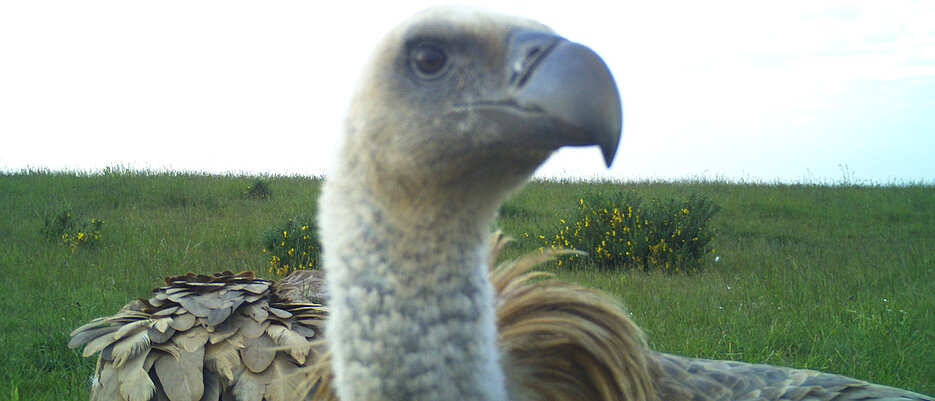Vultures in the Eifel
06/23/2023In cooperation with several German national parks, researchers from the University of Würzburg are investigating the role of carrion in our ecosystems. In the Eifel National Park, unusual guests recently testified to the success of the project.

Wild animal carcasses are a hotspot for biodiversity; many organisms cavort in and around them: from bacteria to fungi, insects, mammals to birds such as the griffon vulture, a species that has been extinct in Central Europe for centuries.
The latter was recently confirmed on the Dreiborn plateau in the Eifel National Park. A few hours after the targeted laying of a deer carcass, a total of 21 griffon vultures landed there on 6 June 2023, impressively documented by a camera trap. The deer carcass and camera trap were installed in the course of the first Germany-wide large-scale carcass ecology project.
16 national parks involved
As one of 16 German national parks, the Eifel National Park has been a partner of the project executing agency, the University of Würzburg (JMU) since the first of October 2022 in the Federal Agency for Nature Conservation (BfN) funding project to test wildlife carcass release in the landscape.
Project supervisor and wildlife researcher Sönke Twietmeyer from the Eifel National Park Administration was able to identify Spain and France as the vultures' countries of origin based on the ringing of three individuals. They are probably mainly juvenile griffon vultures that do not breed in their first years of life. The 21 vultures ate all but a few bones of the laid deer within a few hours. The following noon, they left the national park again and flew in a south-westerly direction.
Vultures are usually only short-term guests
The spectacular event impressively demonstrates the value of dead animal biomass also for the conservation of strictly protected and very rare species - such as the griffon vulture: "An astonishingly small effort - laying out a game carcass that is otherwise quickly removed in common practice under camera trap observation - can bring even these initially unexpected species back to our protected areas in high numbers of individuals," explains project coordinator Dr Christian von Hoermann from the University of Würzburg.
As early as 2006, an unprecedented vulture flight of at least 164 individuals was recorded in Germany. Since then, single individuals or small groups have been flying to Germany every summer. However, due to the lack of dead animals in the landscape, they usually only stay in one place for a very short time. In the Eifel National Park, individual vultures have been observed almost every year for the last seven years, often just flying over the area. In 2017, there was even a troop of 96 vultures passing through. Two griffon vultures and one black vulture even stayed for a few days.
The project team at the University of Würzburg is thrilled about this response to the project: "You can see that nature is ready for more process protection, it's often just up to us" says project leader Professor Jörg Müller from the Department of Zoology III.
Contact
Dr Christian von Hoermann, Research Associate, Chair of Zoology III, University of Würzburg, christian.hoermann-von-und-zu-guttenberg@uni-wuerzburg.de







